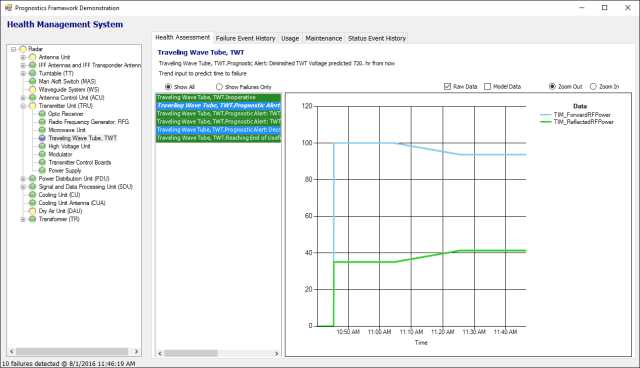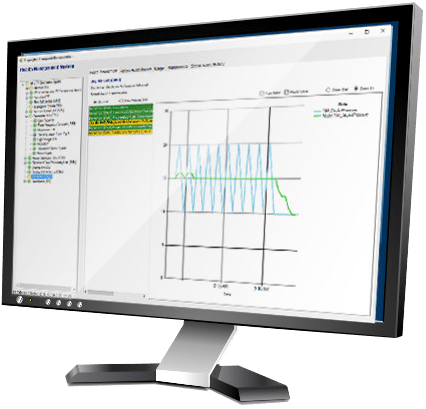Prognostics Framework (PF)
Model-based Expert System provides real-time prognostics, diagnostics, and status monitoring to support remote monitoring and proactive maintenance solutions.
APPLICATIONS:
Health Management Systems (HMS)
Embedded Prognostic & Diagnostic Systems
Condition-based Maintenance (CBM) Systems
Predictive Anticipatory Maintenance
Remote Monitoring
Smart Sensor Applications
Off-platform Time Series Analysis
Off-platform Proactive Maintenance Solutions
Make the Move from Reactive to Proactive
The Prognostics Framework is a software framework for integrating vast amounts of data from many sources, analyzing that data and turning that data into actionable information. Any mathematical prognostic algorithm can be hosted within the framework including condition monitoring, trending, symptom relationships and Remaining Useful Life (RUL). The end result is a software application which knows the condition of the system now and into the future and can answer the following questions:
- What is the operational capability of my system?
- What operator actions are required?
- What immediate repair actions are required?
- How should preventative maintenance be scheduled?
- What spares and tools are needed in the near future?
The goal of the Prognostics Framework is to make today’s complex and distributed systems more reliable and secure.
Benefits include:
- Reduced down-time
- Failure avoidance
- Accurate readiness assessment
- Decision support
- Proactive maintenance
- Anticipatory spares and logistics
Physics Based Approach
 There are many methods being explored in industry and academia today to implement failure prediction solutions. The Prognostics Framework’s model-based approach offers a way to host many of these methods in an architecture which can be deployed forward and used to analyze real-time or near real-time data. Some failures can be detected and predicted using physics-based approaches and first principles of design coupled with expert knowledge of correlations between the data captured and failure modes. Other failures are better detected and predicted using data-driven techniques, including data sampling during known good modes of operation to define nominal ranges. In short, model-based prognostics provides a flexible framework which can be used to host many varied methods and algorithms. Model development can be automated to import existing Computer Aided Design (CAD) design data, Failure Modes Effects and Criticality Analysis (FMECA) data, Failure Reporting Analysis and Corrective Action System (FRACAS) results and other engineering data from spreadsheets or eXtensible Markup Language (XML) inputs. These automated capture techniques, coupled with user-friendly development software which focuses on capturing only the data needed to drive run-time analysis, can greatly reduce model development time.
There are many methods being explored in industry and academia today to implement failure prediction solutions. The Prognostics Framework’s model-based approach offers a way to host many of these methods in an architecture which can be deployed forward and used to analyze real-time or near real-time data. Some failures can be detected and predicted using physics-based approaches and first principles of design coupled with expert knowledge of correlations between the data captured and failure modes. Other failures are better detected and predicted using data-driven techniques, including data sampling during known good modes of operation to define nominal ranges. In short, model-based prognostics provides a flexible framework which can be used to host many varied methods and algorithms. Model development can be automated to import existing Computer Aided Design (CAD) design data, Failure Modes Effects and Criticality Analysis (FMECA) data, Failure Reporting Analysis and Corrective Action System (FRACAS) results and other engineering data from spreadsheets or eXtensible Markup Language (XML) inputs. These automated capture techniques, coupled with user-friendly development software which focuses on capturing only the data needed to drive run-time analysis, can greatly reduce model development time.
Focus on Meaningful Recommendations
 It’s easy for many Preventative Health Management (PHM) and Condition Based Maintenance (CBM) systems to get lost in the vast amounts of data that can be collected from today’s systems. A key aspect of the Prognostics Framework is its focus on making meaningful recommendations based on its data analysis. In its most basic form, the output of the Prognostics Framework analysis is a list of current faults and impending predicted faults within the target system. However, each fault is then taken one step further and linked to the following types of information to make its detection meaningful. First, each fault includes a time frame (e.g. failure predicted within 72 hours), a confidence in that prediction (e.g. based on data inputs the failure prediction has a 75% probability) and criticality assessment (e.g. this fault is fatal to system operation or only degrades system performance). Secondly, each fault includes tags to parts ordering systems (e.g. the replaceable item is part number 1457 and NIIN/NSN 6240-00-027-2059) and the repair procedure which is required (e.g. the required repair is procedure TM-2311-01). This type of information supports logistics and maintenance planning and management. Maintenance becomes proactive based on the actual condition of the system and any stress it may have encountered. In addition, each fault can be tagged to an operations action which supports failure avoidance (e.g. power down transmitter #2). Finally, the impact of faults can be modeled across operational functions over time to define the impact of these faults to the operational capabilities of the target system now and in the near future. This type of information supports operations and decision making.
It’s easy for many Preventative Health Management (PHM) and Condition Based Maintenance (CBM) systems to get lost in the vast amounts of data that can be collected from today’s systems. A key aspect of the Prognostics Framework is its focus on making meaningful recommendations based on its data analysis. In its most basic form, the output of the Prognostics Framework analysis is a list of current faults and impending predicted faults within the target system. However, each fault is then taken one step further and linked to the following types of information to make its detection meaningful. First, each fault includes a time frame (e.g. failure predicted within 72 hours), a confidence in that prediction (e.g. based on data inputs the failure prediction has a 75% probability) and criticality assessment (e.g. this fault is fatal to system operation or only degrades system performance). Secondly, each fault includes tags to parts ordering systems (e.g. the replaceable item is part number 1457 and NIIN/NSN 6240-00-027-2059) and the repair procedure which is required (e.g. the required repair is procedure TM-2311-01). This type of information supports logistics and maintenance planning and management. Maintenance becomes proactive based on the actual condition of the system and any stress it may have encountered. In addition, each fault can be tagged to an operations action which supports failure avoidance (e.g. power down transmitter #2). Finally, the impact of faults can be modeled across operational functions over time to define the impact of these faults to the operational capabilities of the target system now and in the near future. This type of information supports operations and decision making.
About the Technology
The Prognostics Framework software includes an Integrated Development Environment (IDE) for developing the prognostic/diagnostic model which is then paired with the run time software component to perform prognostics, diagnostics and status monitoring. The software is scalable, extensible and hardware independent, taking data from any source. The run time software was developed in C and is designed to process large streams of data in continuous operation. It can be compiled to a wide variety of environments including Microsoft Windows, Linux and Real-Time Operating Systems (RTOS). Software interfaces for Microsoft.NET, Java and C/C++ are included. The software architecture enables a wide variety of applications through its software service approach, offering a library of functions which can be invoked as needed by the host application. The run time software is designed to accept streams of data and is well suited for embedded applications.
Military and Commercial Significance
The Prognostics Framework is a key component of the ADSSS solution for the U.S. Navy Littoral Combat Ship (LCS) Condition Based Maintenance (CBM) system. It analyzes all data collected by ADSSS using the IEEE SIMICA XML data format. In this application, all raw data and analysis is stored in a centralized database hosted by the U.S. Navy and provided to LCS support personnel via a Web Application portal which includes a dashboard displaying the condition of all LCS activities and user downloadable reports. Condition based prognostics, Remaining Useful Life (RUL), diagnostics interpretation of BIT codes, and status monitoring are performed for the SPS-77 and SPS-75 radars. Diagnostics and status monitoring are performed for the MK 110, RAM and TIM Smart Sensor devices.
The Prognostics Framework was used to develop the Health Management System (HMS) for the U.S. Army JLENS missile defense system developed by Raytheon. In this application, the Prognostics Framework monitored all of the equipment including the radars, aerostat and all of the ground support equipment such as the control shelter and power generation equipment. The Prognostics Framework application included prognostics, diagnostics, status monitoring, maintenance management and IETM interfaces. The JLENS system was the first system of its kind to require prognostics as a key aspect of its support posture.
Contact Us for a Demo










